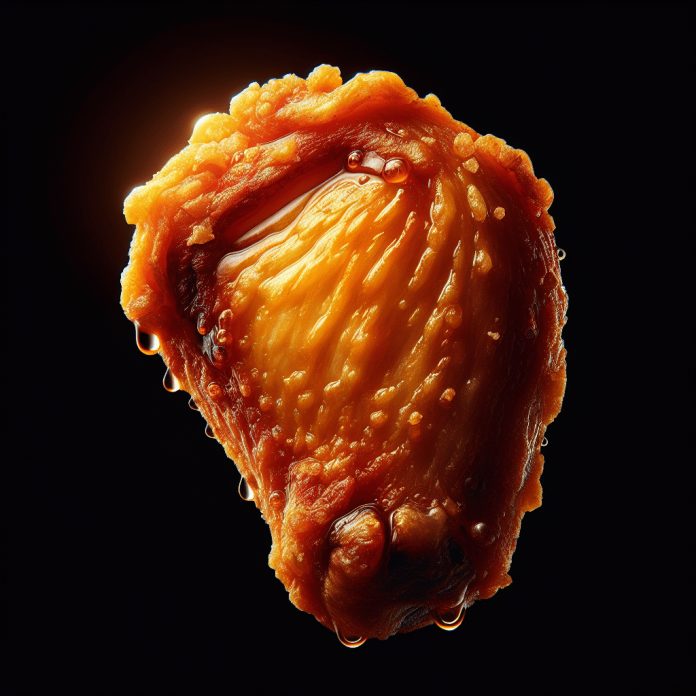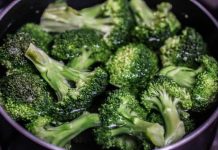Get ready for the perfect snack that is both crispy and juicy without the guilt or the hassle of deep frying – Air Fryer Chicken Wings! In just 20 minutes, your taste buds will be treated to the most delicious, finger-licking wings you’ve ever had. With the magic of air frying, these wings come out perfectly golden brown on the outside, while remaining tender and juicy on the inside. Say goodbye to greasy fingers and hello to a healthier, yet equally tasty alternative. So grab your air fryer and get ready to indulge in some mouthwatering wings like never before.
Choosing the Right Chicken Wings
When it comes to making delicious air fryer chicken wings, choosing the right type of wings is crucial. Let’s explore the options available and how they can impact the final result.
Fresh vs Frozen
The first decision you’ll need to make is whether to use fresh or frozen chicken wings. While both options can work well in an air fryer, there are a few things to consider.
Fresh wings are often preferred for their flavor and texture. They tend to have a juicier and more tender meat, which can result in a more enjoyable eating experience. However, fresh wings can be harder to find and may require more preparation time.
On the other hand, frozen wings offer convenience and are readily available in most grocery stores. They are often pre-cut and come in various flavors and styles. While they may lack the same juiciness as fresh wings, they can still yield delicious and crispy results when cooked properly.
Bone-in vs Boneless
Another factor to consider is whether you prefer bone-in or boneless wings. Bone-in wings tend to have more flavor and provide a satisfying eating experience, as you can savor the meat around the bone. They also tend to stay juicier throughout the cooking process. However, some people prefer the convenience and ease of eating boneless wings.
Ultimately, the choice between bone-in and boneless wings comes down to personal preference. Both options can be cooked in the air fryer, so choose whichever style you enjoy the most.
Skin-on vs Skinless
The debate between skin-on and skinless chicken wings is often a hot topic among wing lovers. The skin is where much of the flavor and crispiness comes from, so many people prefer to keep it on. However, if you’re looking for a healthier option or want to cut down on calories, removing the skin can be a good choice.
Keep in mind that skinless wings may require a bit more seasoning or marinating to enhance the flavor. If you decide to go with skin-on wings, make sure to pat them dry before cooking to achieve a crispy exterior.
Preparing the Chicken Wings
Before you start cooking your chicken wings in the air fryer, there are a few essential preparation steps to ensure the best results. Let’s take a closer look at each one.
Thawing Frozen Wings
If you’ve opted for frozen wings, it’s important to thaw them properly before cooking. Thawing in the refrigerator overnight is the safest method to ensure even thawing without compromising the meat’s quality. However, if you’re short on time, you can also use the defrost setting on your microwave or place them in a sealed plastic bag and submerge them in cold water.
Avoid thawing wings at room temperature, as this can lead to bacterial growth and foodborne illnesses. Once thawed, make sure to pat the wings dry with paper towels to remove any excess moisture.
Dry Brining
Dry brining is a technique where you sprinkle salt on the chicken wings and let them sit in the refrigerator for a few hours or overnight. This process helps to enhance the flavor and juiciness of the meat. Simply season the wings with salt, place them on a tray, and refrigerate for the desired duration.
Dry brining also helps to remove excess moisture from the skin, resulting in a crispier texture. Just before cooking, rinse off the excess salt and pat the wings dry.
Marinating
Marinating is another popular way to infuse flavor into chicken wings. Whether you prefer a simple marinade or a more complex blend of herbs and spices, marinating can take your wings to the next level.
To marinate chicken wings, combine your desired ingredients in a bowl or zip-top bag and add the wings. Make sure the wings are fully coated in the marinade and refrigerate for at least 30 minutes, but ideally, leave them overnight to maximize flavor infusion.
Seasoning Options
If you’re short on time or prefer a simpler approach, seasoning your wings right before cooking can still result in flavorful and delicious results. There are countless seasoning options available, from classic choices like salt, pepper, and garlic powder to more adventurous blends like Cajun or lemon pepper.
Don’t be afraid to experiment with different seasonings and find the combinations that you enjoy the most. Remember to season both sides of the wings evenly for a balanced flavor.
Preheating and Prepping the Air Fryer
Properly preheating and prepping your air fryer is essential to ensure the chicken wings cook evenly and achieve that perfect crispiness. Let’s go over the necessary steps.
Preheating the Air Fryer
Before adding the wings, it’s crucial to preheat your air fryer to the recommended temperature. Preheating allows the wings to start cooking immediately, creating that satisfying crispy texture.
Most air fryers have a preheat function or allow you to set the desired temperature manually. Preheating typically takes around 3-5 minutes, allowing you to use that time to finish any last-minute preparations.
Adjusting Temperature and Time
Different air fryers may have variations in temperature and cooking times. It’s essential to refer to your specific air fryer’s manual for the recommended settings. However, a general guideline for cooking chicken wings is to set the temperature to 400°F (200°C) and cook for approximately 20 minutes, flipping halfway through.
Keep in mind that the actual cooking time may vary depending on the size and thickness of your wings, so it’s important to monitor them as they cook and adjust the time accordingly.
Lining the Basket with Parchment Paper
To prevent the wings from sticking to the basket and to make cleanup easier, consider lining the air fryer basket with parchment paper. Parchment paper allows the hot air to circulate evenly around the wings while preventing them from sticking to the surface.
To line the basket, simply cut a piece of parchment paper to fit the bottom. It’s crucial to trim any excess paper that extends beyond the basket’s edges to prevent it from interfering with the air circulation.
Cooking the Chicken Wings
Now it’s time to cook the chicken wings in the air fryer. Follow these steps to achieve crispy and delicious results.
Coating Options for Crispy Texture
To achieve that desirable crispy texture, you can coat the wings with various breading options. A popular choice is using a mixture of flour and cornstarch or using panko breadcrumbs. These coatings help create a crunchy exterior while keeping the meat tender and juicy.
Before coating the wings, make sure they are dry and free from excess moisture. Dip each wing into the chosen coating mixture, ensuring they are fully coated. Shake off any excess coating before placing the wings into the air fryer basket.
Applying Cooking Spray
To enhance the wings’ crispiness and prevent sticking, lightly coat them with cooking spray before placing them in the air fryer. This step helps promote browning and ensures an even and consistent texture.
Using a cooking spray rather than drizzling oil allows you to keep the wings healthier while still achieving that desired crispy exterior. Make sure to spray evenly on both sides of the wings to ensure all areas are coated.
Arranging Wings in the Air Fryer
Properly arranging the chicken wings in the air fryer is essential for even cooking. Avoid overcrowding the basket, as this can prevent proper air circulation and result in unevenly cooked wings.
Arrange the wings in a single layer, leaving space between each piece to ensure they cook evenly. If needed, cook the wings in batches to maintain the best cooking conditions. Remember to shake the basket gently to rotate the wings halfway through the cooking process.
Cooking in Batches if Needed
When cooking a larger batch of wings, it may be necessary to cook them in multiple batches rather than overcrowding the air fryer. Overcrowding can lead to uneven cooking and a less crispy texture.
If you need to cook in batches, keep the cooked wings warm by placing them on a wire rack set over a baking sheet in a low-temperature oven. This way, they will stay crispy and hot until all the wings are ready to be served.
Monitoring and Flipping Wings
To ensure your wings cook to perfection, it’s important to monitor and flip them during the cooking process. Here are some tips for achieving optimal results.
Checking for Doneness
To determine if the wings are cooked through, you can perform a visual and tactile check. The color of the wings should be golden brown, and the meat should be opaque and no longer pink.
Additionally, you can insert a meat thermometer into the thickest part of the wing and ensure it reaches an internal temperature of 165°F (74°C). This guarantees that the wings are safe to eat and have reached the desired level of doneness.
Flipping the Wings
Flipping the wings halfway through the cooking time helps to ensure even browning and crispiness on both sides. Using tongs, carefully flip each wing individually, taking care not to damage the crispy coating.
Give the basket a gentle shake to help redistribute the heat and further promote even cooking. This step is essential for achieving uniform results and crispy wings all around.
Adding Extra Seasoning
If you prefer an extra burst of flavor, you can add additional seasoning to the wings when flipping them. A sprinkle of your favorite spices or a light brush of sauce can take your wings to the next level.
Avoid adding excessive amounts of sauce or seasoning, as this can make the coating soggy and prevent the wings from achieving optimal crispiness. The goal is to enhance the flavor while maintaining the desired texture.
Using a Meat Thermometer
To ensure your chicken wings are cooked to perfection, it’s always a good idea to use a meat thermometer. This ensures that the wings reach a safe internal temperature of 165°F (74°C), eliminating any risk of undercooking or foodborne illnesses.
Insert the thermometer into the thickest part of the wing, making sure not to touch the bone. Once the wings reach the recommended temperature, you can confidently remove them from the air fryer and serve.
Achieving Crispy and Juicy Results
To achieve the ideal balance of crispy exterior and juicy interior, there are a few additional tips and tricks to keep in mind.
Avoiding Overcrowding
We cannot stress enough the importance of avoiding overcrowding the air fryer basket. Overcrowding can hinder proper air circulation and prevent the wings from achieving that desired crispy texture.
When arranging the wings in the basket, make sure to leave space between each piece. This allows the hot air to flow evenly around the wings and ensure they cook uniformly.
Using High Heat
For optimal results, it’s recommended to cook the chicken wings at a high temperature, typically around 400°F (200°C). The high heat helps to create that crispy exterior while ensuring the meat remains tender and flavorful.
Cooking at lower temperatures can result in a less crispy texture and a longer cooking time, which may cause the wings to dry out. Stay within the recommended temperature range and adjust the time accordingly for the best results.
Shaking the Basket
Shaking the air fryer basket during the cooking process is an effective way to promote even cooking and achieve that desired crispiness. Gently shake the basket every 5-10 minutes to ensure all sides of the wings are evenly exposed to the hot air.
This shaking motion helps to prevent the wings from sticking together and ensures they brown evenly on all sides. Just be cautious not to shake too vigorously or flip the wings out of the basket.
Spritzing with Oil
If you desire an extra-crispy exterior, you can lightly spritz the wings with oil or cooking spray during the cooking process. This step helps to enhance browning and can result in an even crunchier texture.
Using an oil mister or spritzer, lightly coat the wings with a thin layer of oil. Be careful not to add too much oil, as this can lead to a greasy end result. A light spritz is sufficient to achieve that extra crispiness.
Serving and Enjoying the Wings
The moment has finally arrived to take your air fryer chicken wings out of the basket and enjoy their crispy and juicy goodness. Here are a few tips for serving and enhancing your wing-eating experience.
Resting Before Serving
Allowing the wings to rest for a few minutes before serving helps to lock in the juices and allows the exterior to crisp up further. Place the cooked wings on a wire rack or a paper towel-lined plate to allow any excess oil to drain.
Resting also gives you an opportunity to prepare any condiments or dipping sauces, ensuring everything is ready when the wings hit the table. This brief waiting period enhances the overall flavor and texture of the wings.
Choosing Dipping Sauces
Dipping sauces can take your air fryer chicken wings to a whole new level of deliciousness. From classic choices like ranch or blue cheese to more daring options like spicy sriracha or tangy barbecue, the possibilities are endless.
Consider offering a variety of dipping sauces to cater to different taste preferences. Whether you prefer creamy, tangy, or spicy, there’s a dipping sauce out there to elevate your wing experience.
Garnishing and Serving Suggestions
To further enhance the presentation and flavor of your chicken wings, consider garnishing them with fresh herbs, such as parsley or cilantro. These vibrant green garnishes can add visual appeal and a burst of freshness to the dish.
When serving the wings, provide ample napkins or wet wipes, as eating wings can be a messy but enjoyable experience. Get ready to dig in and savor every bite of those crispy, juicy wings!
Pairing with Side Dishes
Chicken wings are often enjoyed as a snack or appetizer, but they can also make a delicious main course. To turn your air fryer wings into a complete meal, consider pairing them with complementary side dishes.
Classic accompaniments like French fries or coleslaw are always a hit. For a healthier option, opt for a side salad or roasted vegetables. You can also get creative and explore different side dish combinations to elevate your culinary experience.
Tips and Troubleshooting
Cooking chicken wings in an air fryer can be a breeze, but it’s always helpful to have some tips and troubleshooting advice on hand. Here are a few common concerns and how to address them:
Preventing Dry Wings
To prevent your wings from drying out during the cooking process, make sure you don’t overcook them. Keep an eye on the recommended cooking time, and use a meat thermometer to ensure they reach an internal temperature of 165°F (74°C). Overcooking can result in dry and tough wings.
Additionally, avoid removing the skin if you’re concerned about dryness, as it acts as a natural barrier and helps retain moisture. Dry brining or marinating the wings before cooking can also help keep them succulent and flavor-packed.
Adjusting Cooking Time for Wing Size
The size and thickness of the chicken wings can affect the cooking time. Larger wings may require additional cooking time to ensure they are cooked through and achieve that desired crispiness.
If you notice that your wings are not cooked to perfection within the recommended time, you can extend the cooking time in small increments, checking for doneness as you go. Keep in mind that every air fryer is different, so it may take some trial and error to find the perfect cooking time for your wings.
Avoiding Soggy Wings
Soggy wings can be a disappointment, but there are a few things you can do to prevent this. First, make sure to dry the wings thoroughly before cooking. Excess moisture can hinder the crispiness of the wings, so pat them dry with paper towels.
Avoid overcrowding the air fryer basket, as this can trap moisture and prevent proper air circulation. Cook the wings in a single layer, leaving space between each piece.
Finally, avoid adding excessive amounts of sauce or wet marinades during the cooking process. While some moisture is necessary, too much liquid can make the coating soggy. If you prefer saucy wings, consider tossing them in the sauce after they are cooked to maintain their crispiness.
Crisping Already Cooked Wings
If you have leftover cooked wings that have become less crispy, don’t worry! There’s a simple trick to bring back their crispiness.
Preheat your air fryer to a high temperature, around 400°F (200°C). Place the wings in a single layer in the basket and cook for a few minutes, flipping them halfway through. This short burst of high heat helps to re-crisp the exterior, giving you that satisfying crunch.
Cleaning and Maintenance
After enjoying your delicious air fryer chicken wings, it’s important to clean and maintain your air fryer for optimal performance and longevity. Follow these steps to keep your air fryer in great shape.
Cleaning the Air Fryer
Allow the air fryer to cool down before cleaning. Once it has cooled, remove the basket and any accessories, such as racks or trays. Wash these parts with warm soapy water, using a soft sponge or cloth.
Be careful not to use abrasive cleaning materials or harsh chemicals, as they can damage the non-stick coating or other components. Once clean, rinse the parts thoroughly and pat them dry.
The main unit of the air fryer should be wiped clean with a damp cloth or sponge. Avoid submerging the main unit in water or using excessive water, as this can damage the electronics.
Removing Residual Grease
If you notice an accumulation of grease or residue on the heating element or walls of the air fryer, you can clean it by using a mixture of water and vinegar. Dampen a cloth or sponge with the mixture and gently rub the affected areas.
Avoid using abrasive materials or metal utensils that can scratch or damage the air fryer’s surfaces. Regular maintenance and cleaning can prevent the buildup of grease and help maintain the air fryer’s performance.
Maintaining the Non-Stick Surface
To prolong the lifespan of the non-stick coating in your air fryer, it’s important to use non-metal utensils when cooking and serving. Metal utensils can scratch the non-stick surface, leading to potential deterioration over time.
Always opt for silicone, wood, or plastic utensils when handling food in the air fryer. These materials are more gentle and less likely to damage the non-stick coating.
Alternative Recipes
While classic air fryer chicken wings are undeniably delicious, it’s always fun to try new flavors and seasonings. Here are a few alternative recipes to explore:
Spicy Buffalo Wings
For those who love a little heat, spicy buffalo wings are a classic favorite. Toss the cooked wings in a mixture of melted butter and your favorite hot sauce, such as Frank’s RedHot. Adjust the heat level to suit your preference, and serve with ranch or blue cheese dressing for dipping.
Honey BBQ Wings
For a sweet and tangy twist, honey BBQ wings are a crowd-pleaser. Coat the cooked wings in a blend of your favorite BBQ sauce and honey. Add a touch of garlic powder and a dash of Worcestershire sauce for extra flavor. The result is a sticky, finger-licking goodness that will keep you coming back for more.
Lemon Pepper Wings
Lemon pepper wings offer a fresh and zesty flavor profile. Combine lemon zest, black pepper, garlic powder, and a pinch of salt. Toss the cooked wings in this seasoning mixture to give them a burst of citrusy goodness. Serve with a side of lemon wedges for an extra pop of freshness.
Teriyaki Wings
For an Asian-inspired twist, teriyaki wings are a delightful choice. Mix together soy sauce, honey, garlic, ginger, and a dash of rice vinegar. Coat the cooked wings in this sweet and savory glaze, and garnish with sesame seeds and green onions. Serve with steamed rice or a side of stir-fried vegetables for a complete meal.
With these alternative recipes, the possibilities for flavorful air fryer chicken wings are endless. Don’t be afraid to get creative and experiment with different seasonings and sauces to find your new favorite wing recipe.




































